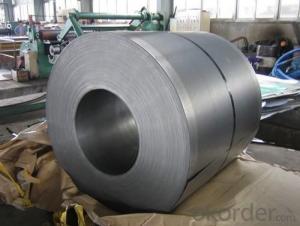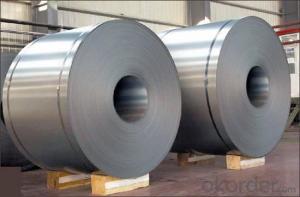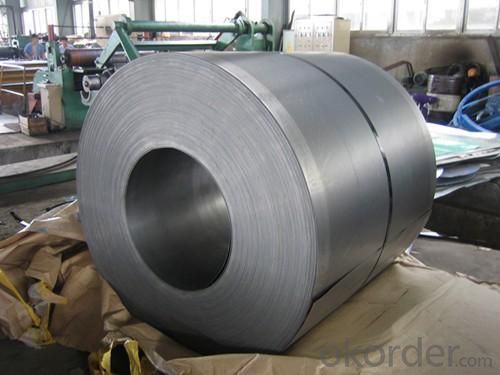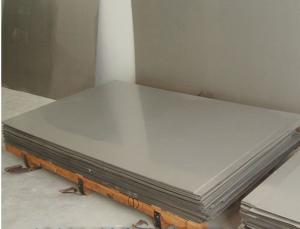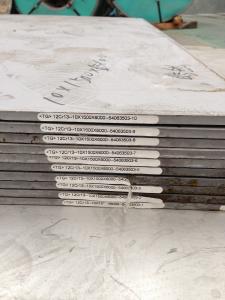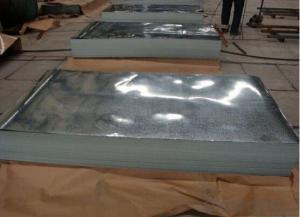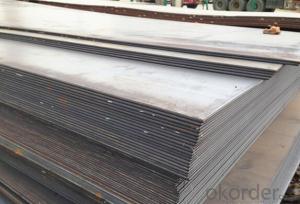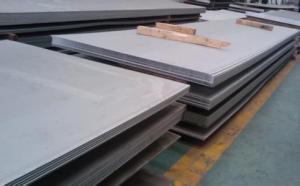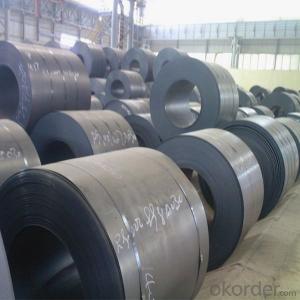cold rolled steel sheet with competetive price
- Loading Port:
- Tianjin
- Payment Terms:
- TT OR LC
- Min Order Qty:
- 500 m.t.
- Supply Capability:
- 10000 m.t./month
OKorder Service Pledge
OKorder Financial Service
You Might Also Like
Quick Details
Standard: ASTM, DIN, GB, JIS
Grade: SPCC
Place of Origin: Hebei, China (Mainland)
- Type: Steel Coil
Technique: Cold Rolled
Surface Treatment: Other
Application: Other
Technique: Cold Rolled
Surface Treatment: Coated
Packaging & Delivery
| Packaging Details: | mill standard |
|---|---|
| Delivery Detail: | 25 days after receiving the deposit |
Specifications
Hot rolled sheet in coil: Specification 2.0mm-15.5mm;
Material: Q235, SS400, SPHC, 16Mn, 16MnR, 20G, 65Mn.
.Sales of the steel products
1. Steel pipes
(1) Seamless steel pipe: material 20#, 45#, 16Mn; Specification dia:57mm-dia:630mm.
(2) High-frequency welded pipe: material Q235A/B; Specification dia:15mm-dia:159mm.
(3) Galvanized pipe: material Q235A/B; Specification dia:15mm-dia:80mm.
(4) Stainless steel pipe: material 304, 316, 321, 430; Specification dia:15mm-dia:159mm.
(5) Cast iron pipe: material is spherulitic graphite cast iron, 18#, 22# pig iron.
2. Steel plate
(1) Cold rolled sheet in coil, cold rolled sheet in box: Specification 0.4mm-3.0mm; Material: ST12, SS400, SPHC.
(2) Hot rolled sheet in coil: Specification 2.0mm-15.5mm;
Material: Q235, SS400, SPHC, 16Mn, 16MnR, 20G, 65Mn.
(3) Medium plate: Specification 8.0mm-100mm; Material Q235, 65Mn, 16MnL.
(4) Galvanized sheet: Specification 0.4mm-3.0mm
(5) Stainless steel sheet: Specification 0.3mm-2.0mm; Material 304, 316, 321, 430.
3. Steel section
(1) Angle bar (equal angle and unequal angle)
Specification: 25*25*3, 30*30*3/4, 40*40*4, 50*50*5, 63*63*6, 100*63*10, 125*80*12, 200*125*18.
(2) I-beam: 12mm-560mm
(3) Channel bar: 8mm-450mm
(4) H-beam: various
(5) Steel billet: 120, 150, 200, 300, 400.
(6) Light rail, heavy rail, crane rail: Various specifications and material
4. Steel wire
(1) Wire rod: Specification dia:6.5, 8, 10mm; Material Q235, Q195, 65Mn, H08A.
(2) Deformed steel bar: Specificationdia:16-dia:32; Material 20MnSi.
(3) Round bar: Specification dia:12-dia:300mm; Material Q235, 45#, 16Mn, 40Cr, 35CrMo
- Q: What is the minimum thickness of a steel sheet?
- The minimum thickness of a steel sheet can vary depending on the specific grade and type of steel being used, but it typically ranges from around 0.5 millimeters to 2 millimeters.
- Q: Can steel sheets be used for elevator flooring or platforms?
- Yes, steel sheets can be used for elevator flooring or platforms. Steel is a durable and strong material that can withstand heavy loads, making it suitable for elevator applications. Additionally, steel sheets can be fabricated to meet the required dimensions and specifications for elevator flooring or platforms.
- Q: How do steel sheets perform in high-humidity environments?
- Due to their inherent properties, steel sheets typically exhibit excellent performance in environments with high humidity. Steel is renowned for its strength, durability, and resistance to corrosion, rendering it a suitable material for enduring conditions characterized by excessive moisture. In certain materials, the presence of high humidity can result in the development of condensation on surfaces, thereby accelerating the corrosion process. However, steel sheets are often endowed with protective layers such as zinc or other corrosion-resistant coatings. These coatings function as a barrier against moisture, effectively preventing the onset of rust. Moreover, steel sheets are frequently subjected to galvanization or treatment with specialized coatings like stainless steel or weathering steel. These measures serve to enhance their resistance to humidity and forestall degradation over time. By providing an additional layer of protection, these coatings ensure that steel sheets retain their structural integrity and continue to perform well even in environments with high humidity. It is worth emphasizing that while steel naturally possesses resistance to moisture, the implementation of proper maintenance and care remains crucial to ensure its long-term performance. Regular inspections, cleaning, and the application of suitable sealants or coatings, if necessary, can further fortify steel sheets against the challenges of high humidity. In conclusion, steel sheets are generally well-suited for high-humidity environments due to their strength, durability, and corrosion resistance. Through the application of appropriate coatings and diligent upkeep, steel sheets can uphold their performance and structural integrity even in conditions characterized by an abundance of moisture.
- Q: Are the steel sheets resistant to UV radiation?
- Generally, steel sheets are resistant to UV radiation. Steel, being a highly durable material, can endure exposure to different environmental factors, including UV radiation. However, the level of resistance may differ depending on the specific type of steel and its protective coating. Steel sheets with a superior protective coating, such as galvanized or stainless steel, exhibit greater resistance to UV radiation compared to bare steel. These coatings act as a barrier, preventing direct impact of UV rays on the steel surface and reducing the chances of degradation or discoloration. Moreover, regular maintenance and proper care can further bolster the steel sheets' resistance to UV radiation, ensuring their long-term durability and performance.
- Q: Can steel sheets be used in medical applications?
- Yes, steel sheets can be used in certain medical applications. Stainless steel sheets, in particular, are commonly used in the medical field due to their durability, corrosion resistance, and ease of sterilization. They are used for various purposes including medical instruments, surgical equipment, implants, and prosthetics.
- Q: Do steel sheets have any environmental benefits?
- Steel sheets possess numerous environmental advantages. Firstly, steel is an immensely recyclable material, allowing for multiple reuses without compromising its quality. This notably diminishes the necessity for new steel production, subsequently reducing the extraction of raw materials and the energy consumption associated with manufacturing. Additionally, recycling steel aids in the reduction of greenhouse gas emissions and the preservation of natural resources. Moreover, steel sheets exhibit exceptional durability and longevity. Their high resistance to corrosion means they require minimal maintenance throughout their lifespan. This durability lessens the need for frequent replacements, ultimately decreasing the demand for new steel production and its accompanying environmental impact. Furthermore, steel sheets can contribute to energy efficiency in buildings. When utilized as roofing or cladding material, they provide excellent insulation properties, effectively reducing the requirements for heating and cooling energy. Consequently, this leads to lower energy consumption and a reduced carbon footprint. Additionally, steel sheets possess fire-resistant qualities, thereby enhancing building safety and minimizing the risk of fire-related accidents. This aspect positively impacts the environment by minimizing the release of harmful emissions and pollutants resulting from fires. In conclusion, steel sheets present a range of environmental benefits, encompassing recyclability, durability, energy efficiency, and fire resistance. These attributes contribute to a more sustainable and eco-friendly approach within the construction and manufacturing industries.
- Q: How do steel sheets perform in thermal expansion?
- Steel sheets have a relatively high coefficient of thermal expansion, meaning they expand significantly when exposed to heat and contract when cooled. This property must be considered in applications where precise dimensional stability is required, as thermal expansion can lead to warping or distortion of the steel sheets.
- Q: How do steel sheets handle weathering?
- Steel sheets have been designed to effectively handle weathering. Typically, they are coated with a protective layer, such as zinc or a combination of zinc and aluminum, which creates a barrier against moisture and other environmental elements. This coating, known as galvanization, prevents the steel from corroding or rusting when exposed to rain, snow, and other forms of precipitation. Aside from the protective coating, various chemical processes are used to enhance the steel sheets' resistance to weathering. These processes may involve applying primers, paints, or sealants that further shield the steel from moisture, UV radiation, and extreme temperature fluctuations. Furthermore, the composition of steel itself contributes to its ability to withstand weathering. Steel is primarily comprised of iron, carbon, and other elements, forming an alloy that provides inherent strength and durability. This structural integrity enables steel sheets to resist deformation, cracking, or warping caused by weather-related stresses. However, it is important to acknowledge that even the most well-protected steel sheets may gradually experience some degree of weathering over time. Harsh environmental conditions can gradually degrade the protective coating, resulting in the formation of small areas of rust or corrosion. Regular maintenance, such as cleaning, inspecting, and reapplying protective coatings, can help extend the lifespan of steel sheets and preserve their resistance to weathering.
- Q: Is the steel plate 1.5 meters wide and 2 meters wide at the same price? .
- For specific quotation, you need to consult the seller of the steel plate, you give him the size you want, and he will calculate the situation after cutting to quote you.
- Q: Can steel sheets be used for manufacturing electrical enclosures?
- Yes, steel sheets can be used for manufacturing electrical enclosures. Steel is a commonly used material for constructing electrical enclosures due to its durability, strength, and ability to provide necessary protection for electrical components. The use of steel sheets ensures that the enclosure is sturdy and can withstand various environmental conditions. Additionally, steel offers good electromagnetic shielding properties, which can help protect sensitive electronic equipment from interference. Steel sheets are also fire-resistant, making them suitable for manufacturing enclosures that need to meet safety regulations. Overall, steel sheets are a reliable choice for manufacturing electrical enclosures due to their characteristics and suitability for the purpose.
Send your message to us
cold rolled steel sheet with competetive price
- Loading Port:
- Tianjin
- Payment Terms:
- TT OR LC
- Min Order Qty:
- 500 m.t.
- Supply Capability:
- 10000 m.t./month
OKorder Service Pledge
OKorder Financial Service
Similar products
Hot products
Hot Searches
Related keywords
